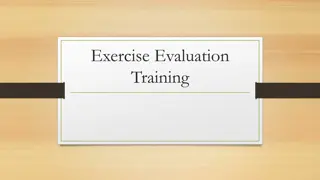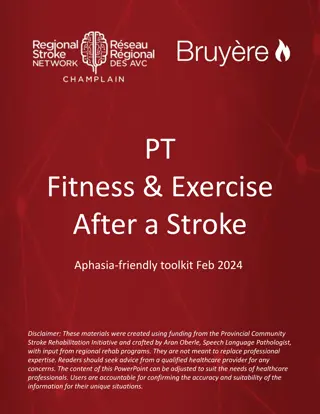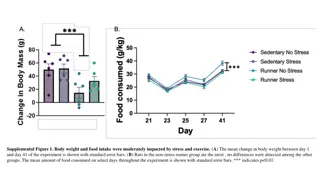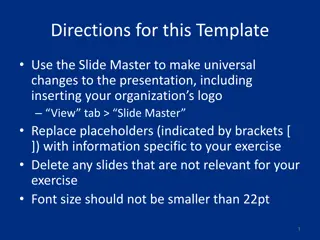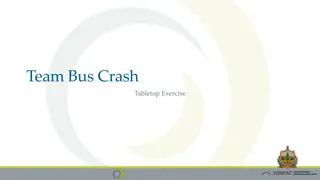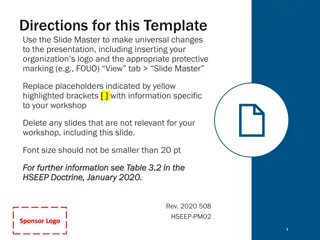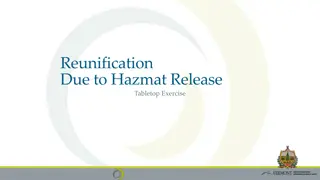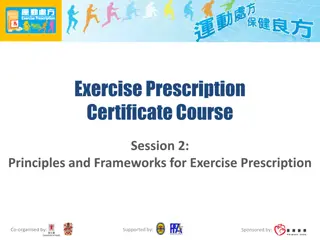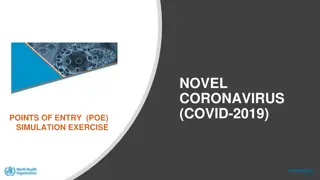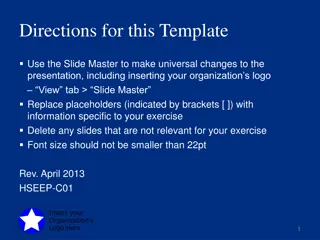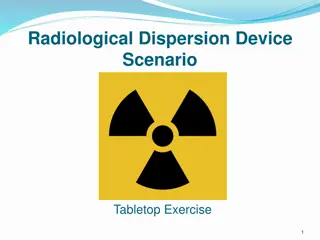Teachings For Exercise - 10F
Dive into the enriching world of teachings related to exercise in "Teachings For Exercise - 10F". Explore valuable insights and guidance to elevate your exercise routine. Whether you are a beginner or a fitness enthusiast, these teachings will inspire and motivate you on your fitness journey. Discover the keys to optimizing your workout regimen and achieving your health goals effectively. Take a step towards a healthier lifestyle with the wisdom shared in this content.
Download Presentation

Please find below an Image/Link to download the presentation.
The content on the website is provided AS IS for your information and personal use only. It may not be sold, licensed, or shared on other websites without obtaining consent from the author.If you encounter any issues during the download, it is possible that the publisher has removed the file from their server.
You are allowed to download the files provided on this website for personal or commercial use, subject to the condition that they are used lawfully. All files are the property of their respective owners.
The content on the website is provided AS IS for your information and personal use only. It may not be sold, licensed, or shared on other websites without obtaining consent from the author.
E N D
Presentation Transcript
Teachings For Teachings For Exercise 10F Exercise 10F
Forces and motion You need to be able to model situations where particles are connected across a pulley When modelling a situation where particles are connected across a pulley, you may need to use Simultaneous Equations 10F
Forces and motion You need to be able to model situations where particles are connected across a pulley Draw a diagram with all the forces on The heavier particle will move downwards, pulling the lighter one upwards Particles P and Q, of masses 2m and 3m, are attached to the ends of a light inextensible string. The string passes over a small, smooth, fixed pulley and the masses hang with the string taut. The system is released from rest. T T Sometimes you have to set up two equations with the information given, and combine them T T 3m 2m a a P Q a) Find the acceleration of each mass b) Find the tension in the string, in terms of m c) Find the force exerted on the pulley by the string, in terms of m d) Find the distance travelled by Q in the first 4 seconds, assuming that P does not reach the pulley e) Comment on any modelling assumptions used 3mg 2mg Equation using P Equation using Q ? = ?? ? = ?? Sub in values Sub in values ? 2?? = 2?? 3?? ? = 3?? ? 2?? = 2?? 3?? ? = 3?? Add the equations together ?? = 5?? Cancel m s and divide g by 5 10F 1.96 = ?
Forces and motion You need to be able to model situations where particles are connected across a pulley Draw a diagram with all the forces on The heavier particle will move downwards, pulling the lighter one upwards Particles P and Q, of masses 2m and 3m, are attached to the ends of a light inextensible string. The string passes over a small, smooth, fixed pulley and the masses hang with the string taut. The system is released from rest. T T Sometimes you have to set up two equations with the information given, and combine them T T 3m 2m a a P Q a) Find the acceleration of each mass b) Find the tension in the string, in terms of m c) Find the force exerted on the pulley by the string, in terms of m d) Find the distance travelled by Q in the first 4 seconds, assuming that P does not reach the pulley e) Comment on any modelling assumptions used 1.96ms-2 3mg 2mg Equation using P Equation using Q ? = ?? ? = ?? Sub in values Sub in values ? 2?? = 2?? 3?? ? = 3?? ? 2?? = 2?? Rearrange to find T ? = 2?? + 2?? Sub in g and a Group up for m ? = 2 1.96 ? + 2 9.8 ? 10F ? = 23.52?
Forces and motion You need to be able to model situations where particles are connected across a pulley The force on the pulley is the tension on both sides these must be added together Particles P and Q, of masses 2m and 3m, are attached to the ends of a light inextensible string. The string passes over a small, smooth, fixed pulley and the masses hang with the string taut. The system is released from rest. T 23.52m T 23.52m 23.52m + 23.52m T T = 47.04m 3m 2m a a P Q a) Find the acceleration of each mass b) Find the tension in the string, in terms of m c) Find the force exerted on the pulley by the string, in terms of m d) Find the distance travelled by Q in the first 4 seconds, assuming that P does not reach the pulley e) Comment on any modelling assumptions used 1.96ms-2 3mg 2mg 23.52m 10F
Forces and motion You need to be able to model situations where particles are connected across a pulley As P does not meet the pulley, we assume Q moves consistently Particles P and Q, of masses 2m and 3m, are attached to the ends of a light inextensible string. The string passes over a small, smooth, fixed pulley and the masses hang with the string taut. The system is released from rest. 23.52m 23.52m T T 3m 2m a a P Q a) Find the acceleration of each mass b) Find the tension in the string, in terms of m c) Find the force exerted on the pulley by the string, in terms of m d) Find the distance travelled by Q in the first 4 seconds, assuming that P does not reach the pulley e) Comment on any modelling assumptions used 1.96ms-2 3mg 2mg 23.52m ? =? ? = 0 ? =? ? = 1.96 ? = 4 47.04m ? = ?? +1 2??2 Sub in values ? = 0 (4) +1 2(1.96)(4)2 Calculate ? = 15.7? 10F
Forces and motion You need to be able to model situations where particles are connected across a pulley Particles P and Q, of masses 2m and 3m, are attached to the ends of a light inextensible string. The string passes over a small, smooth, fixed pulley and the masses hang with the string taut. The system is released from rest. 23.52m 23.52m T T 3m 2m a a P Q a) Find the acceleration of each mass b) Find the tension in the string, in terms of m c) Find the force exerted on the pulley by the string, in terms of m d) Find the distance travelled by Q in the first 4 seconds, assuming that P does not reach the pulley e) Comment on any modelling assumptions used 1.96ms-2 3mg 2mg 23.52m Comment on the modelling assumptions used: 47.04m Light string The string has no mass 15.7m Inextensible string The particles move with the same acceleration Smooth pulley No Frictional force, tension equal on both sides 10F
Forces and motion Draw a diagram and label all the forces R You need to be able to model situations where particles are connected across a pulley T T A 0.08g Two particles A and B of masses 0.4kg and 0.8kg respectively are connected by a light inextensible string. Particle A lies on a rough horizontal table 4.5m from a small smooth fixed pulley which is attached to the end of the table. The string passes over the pulley and B hangs freely, with the string taut, 0.5m above the ground. The frictional force has a magnitude 0.08g.The system is released from rest. Find: T 0.4g T a a B We can set up separate equations of motion for A and B 0.5m 0.8g Resolving horizontally for A Resolving vertically for B a) The acceleration of the system b) The velocity at which B hits the ground c) The total distance travelled by A before it comes to rest ? = ?? ? = ?? Resolve horizontally Resolve vertically ? 0.08? = 0.4? 0.8? ? = 0.8? Add the two equations together The T s cancel out ? 0.08? = 0.4? 0.8? ? = 0.8? 0.72? = 1.2? Divide by 1.2 10F 0.6? = ?
Forces and motion Draw a diagram and label all the forces R You need to be able to model situations where particles are connected across a pulley T T A 0.08g Two particles A and B of masses 0.4kg and 0.8kg respectively are connected by a light inextensible string. Particle A lies on a rough horizontal table 4.5m from a small smooth fixed pulley which is attached to the end of the table. The string passes over the pulley and B hangs freely, with the string taut, 0.5m above the ground. The frictional force has a magnitude 0.08g.The system is released from rest. Find: T 0.4g T 0.6g 0.6g B We can use SUVAT to calculate the velocity of B as it hits the ground 0.5m 0.8g ? = 0.5 ? = 0 ? =? ? = 0.6? ? =? ? = ?.?? a) The acceleration of the system b) The velocity at which B hits the ground c) The total distance travelled by A before it comes to rest ?2= ?2+ 2?? Sub in values ?2= (0)2+2(0.6?)(0.5) Calculate ?2= 0.6? Square root ? = 2.42?? 1 10F
Forces and motion Draw a diagram and label all the forces R You need to be able to model situations where particles are connected across a pulley T T A 0.08g Two particles A and B of masses 0.4kg and 0.8kg respectively are connected by a light inextensible string. Particle A lies on a rough horizontal table 4.5m from a small smooth fixed pulley which is attached to the end of the table. The string passes over the pulley and B hangs freely, with the string taut, 0.5m above the ground. The frictional force has a magnitude 0.08g.The system is released from rest. Find: T 0.4g T 0.6g 0.6g B Particle A will travel 0.5m by the time B hits the floor 0.5m When B hits the floor, A will be moving at speed (the same as B as it hit the floor ) and will decelerate due to the frictional force We need to know the deceleration of a 0.8g ? = ?.?? a) The acceleration of the system b) The velocity at which B hits the ground c) The total distance travelled by A before it comes to rest ? = ?? Resolve horizontally for A ? = ?.???? ? ? 0.08? = (0.4 ?) T = 0 now as the string will be slack 0 0.08? = 0.4? Divide by 0.4 0.2? = ? 10F
Forces and motion Draw a diagram and label all the forces R You need to be able to model situations where particles are connected across a pulley T T A 0.08g Two particles A and B of masses 0.4kg and 0.8kg respectively are connected by a light inextensible string. Particle A lies on a rough horizontal table 4.5m from a small smooth fixed pulley which is attached to the end of the table. The string passes over the pulley and B hangs freely, with the string taut, 0.5m above the ground. The frictional force has a magnitude 0.08g.The system is released from rest. Find: T 0.4g T 0.6g 0.2g 0.6g B Now we can use SUVAT again to find the distance A travels before coming to rest 0.5m ? =? ? = 2.42 ? = 0 ? = 0.2? ? =? 0.8g ?2= ?2+ 2?? ? = ?.?? Sub in values (remember the initial velocity of A) a) The acceleration of the system b) The velocity at which B hits the ground c) The total distance travelled by A before it comes to rest 02= 2.422+ 2( 0.2?)(?) Calculate ? = ?.???? ? 0 = 5.88 3.92? Rearrange to find s ? = 1.5? Remember to add on the 0.5m A has already travelled! ? = 2? 10F





